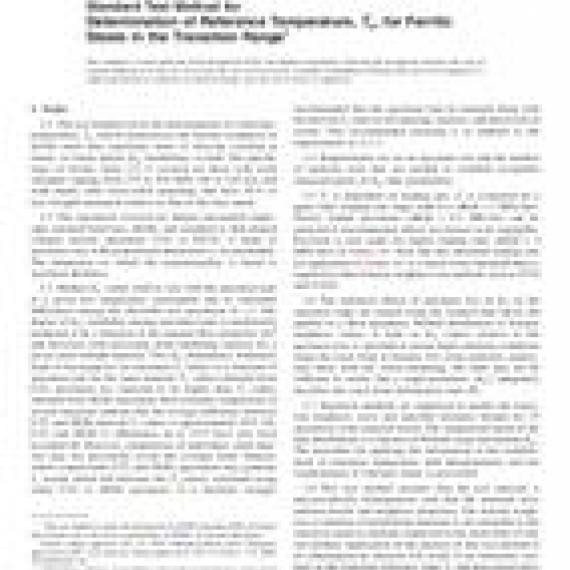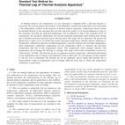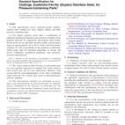No products
ASTM E1921-18
ASTM E1921-18 Standard Test Method for Determination of Reference Temperature, <emph type="bdit">T<inf >o</emph>, for Ferritic Steels in the Transition Range
standard by ASTM International, 01/15/2018
Full Description
1.1This test method covers the determination of a reference temperature, To, which characterizes the fracture toughness of ferritic steels that experience onset of cleavage cracking at elastic, or elastic-plastic KJc instabilities, or both. The specific types of ferritic steels (3.2.1) covered are those with yield strengths ranging from 275 to 825 MPa (40 to 120 ksi) and weld metals, after stress-relief annealing, that have 10% or less strength mismatch relative to that of the base metal.
1.2The specimens covered are fatigue precracked single-edge notched bend bars, SE(B), and standard or disk-shaped compact tension specimens, C(T) or DC(T). A range of specimen sizes with proportional dimensions is recommended. The dimension on which the proportionality is based is specimen thickness.
1.3Median KJc values tend to vary with the specimen type at a given test temperature, presumably due to constraint differences among the allowable test specimens in 1.2. The degree of KJc variability among specimen types is analytically predicted to be a function of the material flow properties (1)2 and decreases with increasing strain hardening capacity for a given yield strength material. This KJc dependency ultimately leads to discrepancies in calculated To values as a function of specimen type for the same material. To values obtained from C(T) specimens are expected to be higher than To values obtained from SE(B) specimens. Best estimate comparisons of several materials indicate that the average difference between C(T) and SE(B)-derived To values is approximately 10C (2). C(T) and SE(B) To differences up to 15C have also been recorded (3). However, comparisons of individual, small datasets may not necessarily reveal this average trend. Datasets which contain both C(T) and SE(B) specimens may generate To results which fall between the To values calculated using solely C(T) or SE(B) specimens. It is therefore strongly recommended that the specimen type be reported along with the derived To value in all reporting, analysis, and discussion of results. This recommended reporting is in addition to the requirements in 11.1.1.
1.4Requirements are set on specimen size and the number of replicate tests that are needed to establish acceptable characterization of KJc data populations.
1.5To is dependent on loading rate. To is evaluated for a quasi-static loading rate range with 0.1 dK/dt 2 MPam/s. Slowly loaded specimens (dK/dt 0.1 MPam) can be analyzed if environmental effects are known to be negligible. Provision is also made for higher loading rates (dK/dt 2 MPam/s) in Annex A1. Note that this threshold loading rate for application of Annex A1 is a much lower threshold than is required in other fracture toughness test methods such as E399 and E1820.
1.6The statistical effects of specimen size on KJc in the transition range are treated using the weakest-link theory (4) applied to a three-parameter Weibull distribution of fracture toughness values. A limit on KJc values, relative to the specimen size, is specified to ensure high constraint conditions along the crack front at fracture. For some materials, particularly those with low strain hardening, this limit may not be sufficient to ensure that a single-parameter (KJc) adequately describes the crack-front deformation state (5).
1.7Statistical methods are employed to predict the transition toughness curve and specified tolerance bounds for 1T specimens of the material tested. The standard deviation of the data distribution is a function of Weibull slope and median KJc. The procedure for applying this information to the establishment of transition temperature shift determinations and the establishment of tolerance limits is prescribed.
1.8This test method assumes that the test material is macroscopically homogeneous such that the materials have uniform tensile and toughness properties. The fracture toughness evaluation of nonuniform materials is not amenable to the statistical analysis methods employed in the main body of this test method. Application of the analysis of this test method to an inhomogeneous material will result in an inaccurate estimate of the transition reference value To and non-conservative confidence bounds. For example, multipass weldments can create heat-affected and brittle zones with localized properties that are quite different from either the bulk material or weld. Thick section steels also often exhibit some variation in properties near the surfaces. Metallography and initial screening may be necessary to verify the applicability of these and similarly graded materials. An appendix to analyze the cleavage toughness properties of nonuniform or inhomogeneous materials is currently being prepared. In the interim, users are referred to (6-8) for procedures to analyze inhomogeneous materials.
1.9This standard does not purport to address all of the safety concerns, if any, associated with its use. It is the responsibility of the user of this standard to establish appropriate safety, health, and environmental practices and determine the applicability of regulatory limitations prior to use.
1.10This international standard was developed in accordance with internationally recognized principles on standardization established in the Decision on Principles for the Development of International Standards, Guides and Recommendations issued by the World Trade Organization Technical Barriers to Trade (TBT) Committee.


































